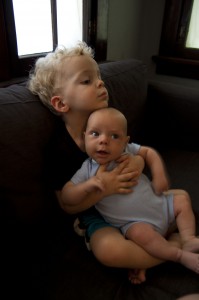
My daughter was weeks old when I realized I needed to get out of the house and find a community. The moment my daughter was born all the systems and strategies I’d read about flew out the window. I realized that I knew what felt right and what my baby needed: closeness, love, attention, and safety. I also realized that I could not sleep unless I could feel her breathing next to me.
I walked into my first API meeting with my baby in arms. Around the room were seated moms chatting, playing with their children, nursing, and laughing. Is this some kind of parenting paradise, I thought. I had never been in a room with mothers nursing toddlers, babies happily asleep in slings amidst the din of happy conversation and so much care for little people. “Welcome to our Attachment Parenting group, we are glad you are here.” said the leader. And so began my first API meeting. I had no idea what Attachment Parenting was when my first child was born. But I knew what felt right and made sense. I had no idea that there was a whole organization filled with people who felt the same and had such riches of experience and knowledge.
The meeting topic was Positive Discipline and I learned about the concept of Time In with a child vs. a Time Out. It made so much sense and yet was so counter to what I had heard my whole life. The idea that a child needs more time, attention, love and special concern when they are out of control made me immediately begin to rethink my preconceptions. Parents shared experiences and difficult situations and I heard over and over the idea that they were looking for what their children needed not how to control them.
And then there were the kids themselves. Babies and toddlers were playing on the floor in the middle of our discussion circle. Sometimes toys were snatched or thrown but I watched closely how mothers spoke to their children at these moments. Short, gentle sentences. Help for those in tears. Emphasis on empathy. But no forced sharing or robotic apologies. The older children orbited our group. Running, talking, laughing and then settling in to play in a fort they had invented under a table. Who is watching them, I kept thinking at first. But as the meeting progressed I noticed this little group of five to nine year olds was incredibly independent and very very kind to one another. I saw a moment when a little girl was trying to get into the fort and couldn’t fit. “Come on, let’s get another chair and put it here.” said another child. Hmm, I thought, this compassion idea isn’t just theory here.
What struck me most about my first API meeting was that I felt at home. I felt that I had a place where I could be open about my parenting questions without fearing that I would be berated with harsh advice. And just to see other parents in action, caring and being present for their children was priceless. I learned that I was not alone that day. I knew walking out that I now had a community: I had found my people!









